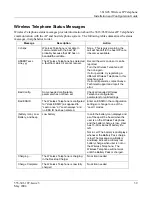
3616/26 Wireless IP Telephone
Installation and Configuration Guide
42
555-301-107, Issue 3
May
2004
Message Description
Action
Multiple GW Res
More than one SVP Server has
responded
Caused by two or more Wireless
Telephones sharing the same IP
address. Assign unique IP
addresses to each Wireless
Telephone.
Network Busy
All APs are full or busy
Try call again later.
Wireless Telephone not administered
on the Avaya Call Server
Wireless Telephone not properly
configured. Verify that extension
and password in the Wireless
Telephone match those
administered in the Avaya Call
Server.
The Avaya Call Server is not working
Verify that the Avaya Call Server is
operational. If so, follow standard
troubleshooting procedures for the
Avaya Call Server.
No LAN connection at the AP or the
Avaya Call Server
Verify the Avaya Call Server
connection to LAN and all APs.
No Call Server IP
or
No Call Server
(when apparently
valid IP, but no
response to the
GRQ/RRQ
process)
The No Call Server
message may
include an error
indication
Wireless Telephone can’t locate the
Avaya Call Server
IP address configuration of the
Avaya Call Server is wrong or
missing.
No Host IP
The Wireless Telephone is configured
for “static IP” (as opposed to “use
DHCP”) and no valid host IP address
(the Wireless Telephone’s IP
address) has been entered.
Enter a valid IP address in the
configuration settings or change to
“use DHCP”.
No IP Address
Invalid IP
Check the IP address of the
Wireless Telephone and re-
configure if required.
No Net Access
•
Cannot authenticate / associate
with AP
Verify the AP configuration.
•
Incorrect WEP settings
Verify that all the WEP settings in
the Wireless Telephone match
those in the APs.
This indicates any of the following:
•
No radio link
Verify that the AP is turned on.
No Net Found
•
No ESSID – Autolearn not
supported (or)
Incorrect ESSID
Verify the ESSID of the wireless
LAN and enter or Autolearn it again
if required.





































